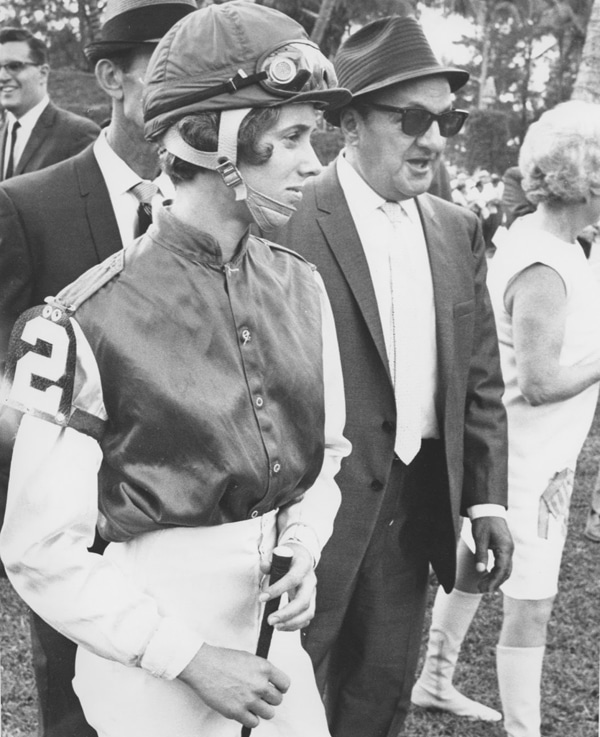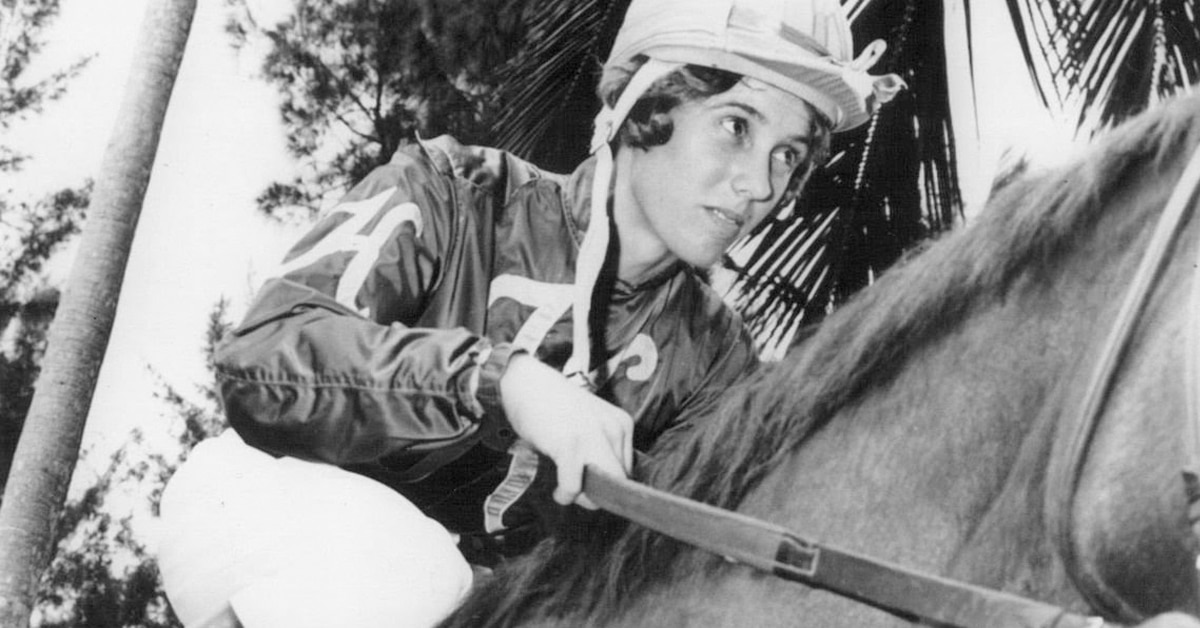Diane Crump is the owner of many “firsts” for women in horse racing. She was the first female jockey in a recognized race, first to ride — and finish in the money — in a stakes race, first to win a stakes race, and the first woman to ride in the Kentucky Derby in 1970.
Of these historic achievements, Crump herself will tell you matter-of-factly that it was just the way things happened according to God’s plan, while doing what she loved. But between the lines of that comment lies a hard-fought battle by Crump and her peers to break through the wall forged by members of racing’s old boys’ club, on their way to becoming America’s first female jockeys.

Crump before her first race. (Jim Raftery/Courtesy of Keeneland Library)
Mark Shrager, Crump’s biographer, immediately points to the perseverance and courage of “the crop of 1969” (his name for that group of women who fought – and won – the battle to obtain jockeys’ licenses and ride in races) during their tumultuous journey and the media frenzy surrounding it. “All of the women that were in that first group, the crop of ‘69, all of them were boycotted, all of them were bad-mouthed and they had to be heroic, they had to be strong as anything to make it through and they did,” Shrager tells me.
I asked Crump and Shrager to set the scene for me in 1969, when this determined group of female horsewomen pushed to go beyond their regular ranks of exercise riders. Our young women of today might be astounded to hear what these pioneering females endured and why they pressed onward, through scathing media coverage, public backlash and heckling, walkouts by male jockeys, repeated rejections and disapproval by racing’s governing bodies, and even acts of physical violence.
For a blip in history – an important blip – Crump graced the front pages and the front lines. Shrager’s biography of Crump, which is dedicated to all female athletes everywhere, traverses through Crump’s life and love of horses, noting her constant unshakeable faith which carried her through oppression, divorce, horrific accidents and debilitating injuries. All against the backdrop of a movement and moment in US history which she became a part of.
A breakthrough they needed, and a breakthrough they achieved. But literally getting to the starting gate proved hazardously difficult, due largely in part to an unwillingness of the sport, and its male jockeys, to accept a female on a racehorse. Mockingly labeled “jockettes” in the media, their applications were repeatedly rejected by racing’s bureaucracy, and many who attempted to ride were met with boycotts by male jockeys.
Shrager says that these ladies were up against “hundreds of years of prejudice masquerading as “tradition.” A “quotable figure” of the day was Jockey’s Guild director Nick Jemas, who generously and frequently offered public commentary on why women shouldn’t ride in races. His reasons included physical limitations and emotional instability.
Shrager concedes that there were substantial hurdles for the men involved. After all, women riders “were a challenge to the men’s financial and psychological security that had in the past been taken for granted by both genders.” Shrager cleverly unearthed a quote from the great Hall of Famer Eddie Arcaro, who said, “When the guys asked me for advice, I told them they couldn’t have much confidence in themselves if they were worried about riding against girls.”
Personally, it surprised me to see the names on the list of jockeys who were staging boycotts – and successfully getting races cancelled – during this period. Yes, perhaps it was another era, but these are names otherwise assigned nothing but glory in the annals of racing. On the day of Crump’s first ride, for example, the jockeys who boycotted included Ray Broussard, Jorge Velasquez, Carlos Marquez, Angel Cordero Jr., Ron Turcotte, and Dick Winant.

Out of the gate. (Jim Raftery/Courtesy of Keeneland Library)
Replacements were eventually found, but it came down to the final hour of frantic negotiations in a chaotic racing office as the clock ticked toward post time. Management scrambled to avoid a full walkout, which had happened before, most notably when Crump’s counterpart Penny Ann Early was slated to ride in a race at Churchill Downs, and the race was cancelled due to boycott for the first time in the track’s illustrious history.
When asked which of the jocks, if any, were particularly gentlemanly, Crump answers on the spot: “Danny Gargan,” she says. A prerequisite for jockeys was that they have their own saddle, but Crump hadn’t splurged yet on this, given the uncertainty surrounding her chances of riding. Gargan was the kind soul who loaned Crump his saddle for her first race. She never forgot it.
Women such as Early came close in those months, but it was ultimately Crump, on February 7, 1969, navigating a horse named Bridle ’n Bit, who sealed her place in the books as the first female jockey to ride in a Thoroughbred pari-mutuel horse race at a recognized American track.
For a girl who thought of nothing but horses since the age of four, was smuggled into her first Thoroughbred racing jobs as a 16-year-old girl, and had exercised horses for the likes of Moody and LeRoy Jolley and Eddie Yowell, Crump was ready to push forward.
Read the full story at StreamHorseTV


